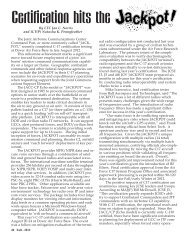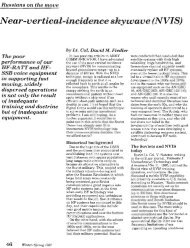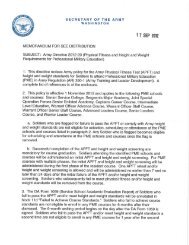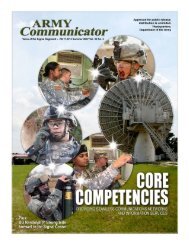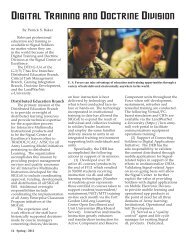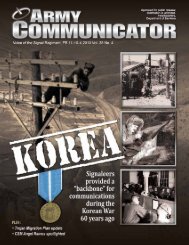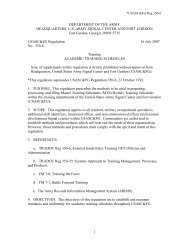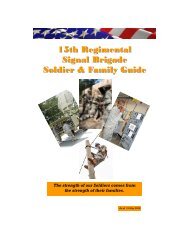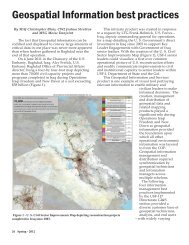AC Summer 08 WIN-T Online - United States Army Signal Center of ...
AC Summer 08 WIN-T Online - United States Army Signal Center of ...
AC Summer 08 WIN-T Online - United States Army Signal Center of ...
Create successful ePaper yourself
Turn your PDF publications into a flip-book with our unique Google optimized e-Paper software.
and will also significantly reduce the<br />
delays associated with two-hop<br />
communications associated with a<br />
hub-based architecture. Operationally,<br />
a mesh architecture is crucial<br />
for transport <strong>of</strong> time critical data, but<br />
may also be required to support<br />
certain types <strong>of</strong> communications<br />
such as duplex voice.<br />
Depending on the frequency<br />
band used (Ku-band), mesh communications<br />
may not be possible for<br />
small terminal to small terminal<br />
communications. Small tactical<br />
mobile SOTM terminals typically<br />
have reduced aperture antennas and<br />
may require more power than is<br />
available from the satellite to close a<br />
one hop link.<br />
In these instances, the NCW<br />
Hub-Assist mode will dynamically<br />
route packets through the Net<br />
Control terminal or alternative NC<br />
to reliably maintain communications.<br />
The NC and alternate NCs<br />
serve as store and forward hubs to<br />
assist NMs and route traffic to the<br />
destination node when the link<br />
cannot be directly closed in a singlehop<br />
link.<br />
NCW will not be new to the<br />
field when it will be introduced<br />
under the <strong>WIN</strong>-T Increment 2<br />
program in FY 11. Early NCW<br />
releases are in use today in the<br />
Mounted Battle Command on-the-<br />
Move program and a quick reaction<br />
program called Triton. The integration,<br />
small scale fielding, and<br />
operational lessons learned have<br />
been invaluable in identifying<br />
technical and operational issues<br />
early and provide improvements to<br />
the system as the <strong>WIN</strong>-T program<br />
moves forward. Periodic technical<br />
and field tests continue at the C4ISR<br />
OTM Test Bed, Fort Dix, N.J., to<br />
mature the system into a high<br />
performance and reliable <strong>WIN</strong>-T<br />
communications network.<br />
Statutory challenges<br />
The <strong>WIN</strong>-T design will capitalize<br />
on ubiquitous commercial Kuband<br />
satellites and military Ka-band<br />
aboard Wideband Global SATCOM<br />
satellites to provide high bandwidth<br />
SOTM capabilities. From a regulatory<br />
perspective, both Ku and Ka<br />
bands present unique challenges to<br />
the <strong>Army</strong>.<br />
Commercial Ku-band<br />
Within the Fix Satellite Service<br />
Ku-band, there are approximately<br />
220 geosynchronous satellites listed<br />
as operational. This density <strong>of</strong><br />
satellites makes adjacent satellite<br />
interference a very significant issue,<br />
especially when using small aperture<br />
SOTM terminals. The current<br />
criteria established for SOTM by<br />
both the FCC (continental <strong>United</strong><br />
<strong>States</strong>) and ITU (outside <strong>of</strong> the<br />
continental <strong>United</strong> <strong>States</strong>), however,<br />
were principally adapted for<br />
shipborne applications and do not<br />
consider ground mobile environments.<br />
PM <strong>WIN</strong>-T has formally<br />
proposed that the regulatory limits<br />
be changed from the rigid go/no-go<br />
<strong>of</strong>f-axis power spectral density<br />
pr<strong>of</strong>ile to an approach using a<br />
statistical model. The statistical<br />
model approach would require a<br />
very low probability <strong>of</strong> exceeding<br />
the <strong>of</strong>f-axis power spectral density<br />
pr<strong>of</strong>ile caused by momentary<br />
pointing errors due to movement <strong>of</strong><br />
the vehicle or ground mobile platform<br />
on which the antenna is<br />
mounted. These proposals are<br />
currently being evaluated at ITU<br />
working groups.<br />
Regardless <strong>of</strong> changes to the<br />
FCC/ITU criteria, dynamic spreading<br />
<strong>of</strong> the radio frequency signal will<br />
be required when using Ku-Band.<br />
The <strong>WIN</strong>-T NCW design has implemented<br />
seven unique spreading<br />
factors which range from 0 to +12 dB<br />
and which are computed based on<br />
the power required to close the link<br />
and the aperture parameters. NCW<br />
optimizes the available satellite<br />
bandwidth by spreading the signal<br />
the minimum amount needed to<br />
avoid ASI.<br />
These changes are distributed,<br />
every 400 milliseconds, to each node<br />
in the network, from the network<br />
controller via the Forward Order<br />
Wire channel. Each <strong>of</strong> the SOTM<br />
terminals planned for <strong>WIN</strong>-T<br />
Increment 2 will comply with the<br />
current criteria established by the<br />
FCC and ITU.<br />
Military Ka-band<br />
For military Ka-band, the<br />
interference environment is not as<br />
severe. The performance criterion<br />
for all earth terminals for military<br />
Ka-band is codified in MIL-STD-188-<br />
164A. Currently, Ka-Band <strong>of</strong>f-axis<br />
limits have not been established in<br />
MIL-STD-188-164A. However, there<br />
is an ITU Radio Regulation that<br />
imposes the requirements for<br />
coordination between geostationarysatellite<br />
networks sharing the same<br />
frequency bands.<br />
Currently, the <strong>Army</strong> is analyzing<br />
the ITU Radio Regulation and<br />
will propose to the MIL-STD community<br />
a maximum permissible <strong>of</strong>faxis<br />
power spectral density from<br />
SOTM earth stations. This will<br />
promote quasi-free interference<br />
satellite operations while maintaining<br />
reasonable SOTM spectral<br />
efficiency.<br />
Summary<br />
Substantial progress has been<br />
realized with respect to addressing<br />
the technical, operational and<br />
statutory challenges associated with<br />
deploying a SOTM based solution to<br />
enable BLOS communications on<br />
warfighting platforms. The initial<br />
widescale deployment <strong>of</strong> this<br />
capability will occur with the <strong>WIN</strong>-T<br />
Increment 2 fieldings <strong>of</strong> PoP and<br />
SNE CIs in FY11. The TCN CI,<br />
which will be owned and operated<br />
by <strong>Signal</strong> Corps personnel, will also<br />
use the SOTM technology to enable<br />
the entire <strong>WIN</strong>-T WAN to operate<br />
on the move. During the course <strong>of</strong><br />
FY <strong>08</strong> -10, PM <strong>WIN</strong>-T will continue<br />
to mature each <strong>of</strong> the SOTM components,<br />
integrate them into functional<br />
B-kit configurations, and subject<br />
them to both developmental and<br />
operational tests.<br />
In addition, several new<br />
advanced NCW features are being<br />
considered for implementation.<br />
Many <strong>of</strong> these features are being<br />
implemented to take advantage <strong>of</strong><br />
new WGS capabilities, including<br />
variable size bandwidth segments<br />
and gain states, not available on<br />
many commercial satellites. Other<br />
features include improvements<br />
related to ease <strong>of</strong> use and maintain-<br />
<strong>Army</strong> Communicator 23



